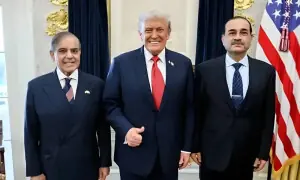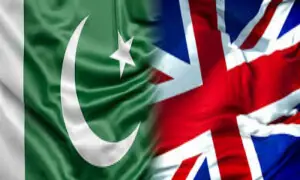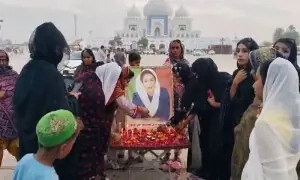Rs3 to Rs262: A political history of Pakistan’s dollar
Generation Z would not believe but the US dollar was available to Pakistanis at as low as Rs25 just a few years ago before they were born. In 30 years, the value of the Pakistani rupee against the US dollar has been eroded nearly 100 times or 948%.
The fall of the rupee — especially when plotted on a graph and juxtaposed to the value of the Indian rupee as we have done here — explains what went wrong with Pakistan and how the generation that finds itself in the prime of youth may avoid repeating the mistakes that were committed in the past three decades.
Summary with links
The birth of the problem 1950-1971
In the 1950s the exchange rate for the US dollar in Pakistani rupees (PKR) was 3.3 and in Indian rupees (INR) it was 4.76, according to data compiled by Professor Werner Antweiler at the University of British Columbia.
This meant that the Pakistani currency was around 70% stronger than the Indian rupee.
But the dominance of Pakistani currency over INR lasted for only until 1956, when the currencies became equal and the US dollar was available to both Pakistan and India at the same rate, that is, 4.7.
In 1956, Pakistan became a republic by promulgating its first constitution. Still, political instability was on the rise and the country was hurtling towards its first Martial Law that came in October 1998.
Indians were not doing any better. Their currency plummeted following the 1965 war with Pakistan. Before the 1971 war, the USD exchange rate was at PKR4.76 and INR7.49.
Afghan dollars 1971-1991
With the fall of Dhaka, the PKR value dropped vis-à-vis the US dollar and INR. The Indian currency was stronger than the Pakistani rupee until 1991 despite a steady supply of dollars to Pakistan during the Afghan Jihad (it was called Jihad back then even by western media).
In 1988, the year Gen Ziaul Haq died in a plane crash, the US dollar was at PKR18 and INR13.91.
This situation began to change with Benazir Bhutto taking over the country. In 1991, the USD exchange rate was at PKR23.8 and INR22.74 –– the Indian currency being 4% stronger than the Pakistani rupee.
It was only in 1992 that the value of the Pakistani rupee rose past its Indian counterpart. The US dollar was being sold at PKR25.08 and INR25.91.
Before and after nuclear explosions 1992-1999
The 1990s are often dubbed as the ‘lost decade’ by historians and political scientists in Pakistan who see the failure of politicians to come together on national issues such as the economy as a major reason propelling Pakistan’s financial woes.
The lines on our bar indicating the exchange rate for PKR and INR seem to confirm this thesis.
The rupee rallied against the Indian currency in 1993 and remained stronger until 1997 despite two civilian governments unable to complete their terms. This was the time the PPP and PMLN joined hands to remove the controversial 8th amendment from the Constitution of Pakistan.
With the 1997 election that awarded a nearly two-thirds majority to Nawaz Sharif, things changed. Political talk was replaced with the heavy-handedness of a heavy mandate. Instability grew, and so did the value of the US Dollar and the Indian rupee against the Pakistani rupee.
With opposition leader Benazir Bhutto living in a self-imposed exile, Nawaz Sharif grew into an autocrat and he was reportedly thinking of taking on the title of Amirul Momeen (the leader of the Muslims).
Pakistan’s May 1998 nuclear tests caused a foreign currency crisis similar to the one we experienced this month (January 2023). India found itself in the same quandary as both countries faced international sanctions.
However, the situation deteriorated for Pakistan a few months after the October 1999 coup by Pervez Musharraf as Pakistan faced international isolation when the civilian government was sent home.
A new Afghan war and dollar supply 2001-2008
Only a few months before the September 11, 2001 attacks in the United States, the dollar rose to Rs63 as the Musharraf regime struggled to reach out to the world and win approval for its October 1999 move.
With 9/11 and the United States declaring a “War of Terror”, Pakistan was back to center stage. The rise of the dollar stemmed then and there.
For the most part of the remaining seven years of Musharraf’s rule, Pakistan enjoyed a steady exchange rate of around Rs60.
In November 2007, Musharraf imposed an emergency after he had a falling out with the top judge, Justice Iftikhar Chaudhry. There were widespread protests by lawyers and stability evaporated. The US dollar price rose against the Pakistani rupee to Rs68 while INR remained stable.
To bring back stability, Musharraf entered into talks with Benazir Bhutto and also allowed the Sharifs to return.
Return of old parties 2009-2018
Elections ushered a civilian government to power once again, but it would take a more than a few years to stabilise the country, economy and rupee.
The new exchange rate was around PKR80 now.
In May 2011, the United States killed Osama Bin Laden in Abbottabad and indicated that it had achieved a major objective of its war on terror. It was preparing to leave the region. Obama announced a drawdown of troops in Afghanistan.
The US and Nato ended their combat missions in Afghanistan in December 2014.
The dollar supply was going to dry up.
Pakistan was in dire need of finding some other sources of dollars — exports maybe. But we never produced goods or services that would have earned us sufficient dollars from the rest of the world.
Between the Abbottabad operation and the July 2017 disqualification of Nawaz Sharif, the price of the US dollar went from PKR86 to PKR105. The Pakistan rupee moved in parallel to the Indian currency. So we can say that Pakistan was doing as good or bad as India.
Then there was surge that appeared between Sharif’s ouster and the general elections held in July 2018. The USD dollar went from PKR105 to PKR121.
Imran Khan’s four years, 2018-2022
The only IMF programs Pakistan completed out of 22 in total was under Nawaz Sharif between 2013 and 2016. However, after the Panama Leaks case and especially the disqualification of Sharif, the country was left on autopilot and the economy rapidly deteriorated.
When Imran Khan came to power there were calls for a new IMF program. Asad Umar, Khan’s first finance minister, procrastinated and approached the Fund only reluctantly. The loan was approved after Umar’s removal.
As Khan procrastinated, the USD dollar rose against the Pakistani rupee to PKR163.
The IMF program help stabilize the economy while political stability was guaranteed by the mantra of being on “one-page” that introduced a rare harmony between the civilian and military leadership.
In 2021, the Pakistani rupee grew a bit stronger. The exchange rate went down from Rs167 in June 2020 to Rs157 in June 2021. It started to rise again, however, within a few months.
The dollar continued to rise as instability returned to the country. When Imran Khan was removed on April 9, it was being traded at PKR184.
The old faces again April 2022 – present
Imran Khan’s removal improved the currency value for only ten days to PKR 180.64 on April 14, 2022, and then on April 20, the USD dollar was again trading at PKR185.
If anyone had expected Imran Khan to leave the political scene after his ouster, their expectation was thwarted. He pushed his narrative through protests and daily press talks and even in video addresses in recent weeks after the live broadcast of his speeches was banned.
But this continues to add to the instability.
Our currency is not likely to stabilize unless the country’s political forces find themselves at peace with each other. This could either be achieved by political talks — as we saw briefly in the early 1990s, but that was only a glimpse — or with the introduction of another “same page” doctrine and rule under another autocrat in which opposition is muzzled.














Comments are closed on this story.